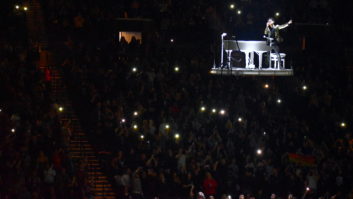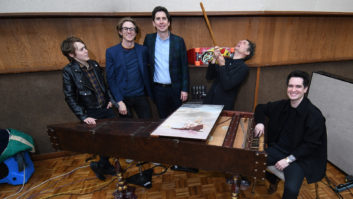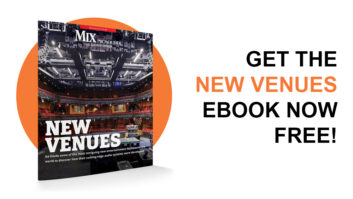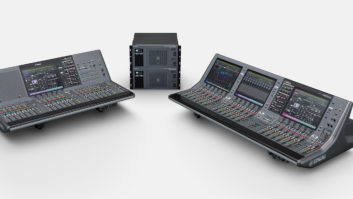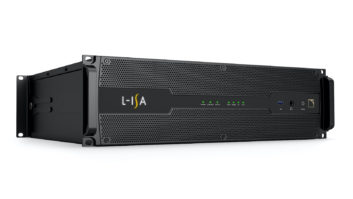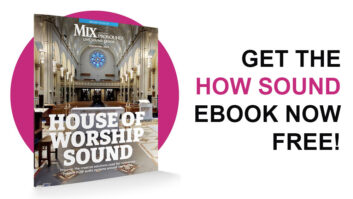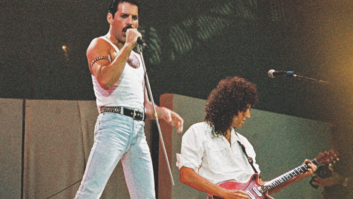Panic! at the Disco started out big in the mid-2000s and then only got bigger. Sporting a wildly varied pop rock sound that recalls everything from Daft Punk to Queen to Frank Sinatra, leader Brendon Urie has staked out the group’s own unique turf, and that in turn led to its spring arena tour behind the recent platinum-selling Death of a Bachelor album. The tour played 36 shows across the country, with FOH engineer/production manager Spencer Jones manning a largely analog audio system provided by Eighth Day Sound (Highland Heights, OH).
“I went analog on this tour with a Midas Heritage 3000,” said Jones. “I’ve been on digital pretty much my whole touring career, but when I had a house gig in Arizona when I lived there, I had an analog desk. I’m just tired of dealing with problems in the digital world versus the convenience; to me, it’s not worth it, especially on this kind of tour where I’m in an arena. I’m the production manager and the front of house guy, and I’ve got real estate—there’s no reason to not carry an analog console if I want one. I have more than 48 inputs, but I did away with what I don’t absolutely need and I made it work with the 48-channel Heritage. It’s fun to mix on—everything’s in front of me, so I’m not flipping through all these different pages. I’ve got one rack and the console; I can see my graphic equalizer, my main bus compression and my vocal compression at all times.”
There was some digital gear to be found at the FOH position—namely Lake processing and some Focusrite gear. “I’m multitracking into a Focusrite RedNet system and recording the shows,” he explained. “That’s one of the conveniences of the digital world—recording straight into Pro Tools or whatever—but I can still record straight off the preamps.” That said, most of the considerable rack at FOH was filled with outboard processing and effects: “I’ve got a couple of TC Electronic 2290s for delay; that’s pretty standard,” he remarked. “I’m using two Bricasti M7s as studio reverb units and I really like those; they sound nice and warm. I’ve got a Lexicon PCM92 and a Yamaha SPX990 for some drum stuff.”
Jones found a variety of interesting ways to effect Urie’s vocals: “I run him through a stereo XTA 31-band graphic that I link to an Empirical Labs Distressor so that I can do more fine-tuning EQ for his vocal, then I use his channel-strip EQ as another effect for certain songs, which is kind of cool. I basically scoop all the low-end out, and make it like an AM radio-type sound for his vocals, so I’ve got an effect just by punching in the EQ at certain parts of the song on the channel strip and then I use the graphic for his main equalization. “One unusual thing I do is I route his vocal through a couple of guitar pedals that I put on a sliding shelf in the rack; I can manipulate them, using them on the lead vocal for some added fun stuff. I’ve got an Electro-Harmonix Holy Grail Nano reverb, which actually sounds really nice as a vocal verb, and I run that with a Boss RE-20 Space Echo.”

Panic! at the Disco spent the spring selling out arenas across North America, covering the crowd with a massive d&b audiotechnik PA provided by Eighth Day Sound.
Rounding out the rack were Smart Research C2 compressors linked to XTA graphic equalizers for mains, subs and front fill outputs; a slew of Aphex gates linked to a four-channel Rane compressor (“I like to comp and gate—that’s one of the things that I got spoiled with on digital that I’m trying to emulate with the analog, having a gate and a compressor on my kick and snare”); four more Smart Research C2 stereo units—one for the drum group and three for six channels of stereo stems; a Summit Audio dual-channel tube compressor for the bass DI and mic; an Avalon tube compressor for the piano group; dbx 160As for background vocals; and more Distressors for the three-piece horn section.
With the seven-piece band, talkbacks and so forth, Jones was looking at roughly 50 inputs—which meant the opening acts’ Avid Venue Profile got drafted as a sidecar.


FOH engineer/production manager Spencer Jones [above] used a Midas Heritage 3000 analog console on the tour, drafting the opening acts’ Avid Venue Profile for use as a sidecar.
Key to making that happen was a four-way split on stage that led to the Heritage and Profile at FOH, and a Heritage 3000 and Avid Venue SC48 at monitors. “I load my file and then I use the Profile at front-of-house as a sidecar,” said Jones. “I don’t need all my talkbacks obviously, but any channel that I don’t necessarily need on the Heritage, I route them through an aux off the Profile into one channel on the console so I can just cue them. That way, during the show if there there’s a problem or the singer’s saying ‘skip this song,’ I can listen to all my talkbacks through the headphones and then I also wire that to a squawk box for line checks. And since I’m doing that, I decided to have a redundant system, so if at any point the Heritage crashes for some reason or the power supplies just aren’t working that day—God forbid, but it hasn’t happened—I could almost immediately start mixing. Because of the four-way split, I can still do the show on the Profile, because I used to; I built that file for three years for this band, so I could easily start mixing it. I’d have to make some adjustments obviously and it wouldn’t sound good, but I could do it.”
As Panic! at the Disco is a Shure endorser, the stage was well-appointed with the brand’s microphones. Drums were covered with a typical Beta 91A and Beta 52A arrangement on the kick, while the snare sported a Beta 57 on top and SM57 on the bottom. A pair of Beta 181s captured the hi-hat and ride cymbals, while Beta 98As nabbed the toms. Meanwhile, the bass was miked with a SM7, “a classic versatile microphone,” Jones opined, while guitars were heard via a SM57 and a KSM313 dual-voice ribbon mic combination. The band’s vocals were captured via KSM8 DualDyne mics—a gold-plated wireless for Urie and wired ones for the backgrounds, expect for the drum vocal, which got a Beta 56A due to the supercardioid pattern. The horns were heard via wireless Beta 98s, while the keys—Roland keyboards in piano shells—were grabbed via Radial ProD2 stereo DIs. Elsewhere, a Radial SW8 8-channel passive auto-switcher was used for tracks, and multiple Radial JDIs could be found across the stage, the one exception being an A Designs REDDI Tube DI used on bass.
The result of all that gear was a mix that Jones used to rock the arenas, albeit conscientiously. “I like a lot of low end, nice clarity on the top, and I’m averaging 102 decibels,” he said “That’s as high as I ever want to average, but the crowd is loud. It’s 80 percent 14 to 22-year-old females, so they’ll sing along and if he hits a high note, they can hit 112…. So basically I try to get the mix to where you can hear everything in the band, you can hear every element, but you can also hear the crowd singing along. Everyone seems to be happy, so it’s a really fun show to mix.”
Eighth Day Sound
Eighthdaysound.com
Shure
Shure.com
Radial
Radialeng.com
